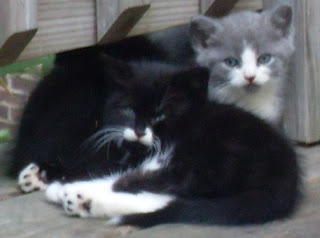A couple of
comments at UniversalHub tell us that it's a Zoo on Fort Hill, with raccoons and skunks. We've seen opossums, too.
And cats. Feral cats.
A jet black mother cat was zonked out on the back porch the day before yesterday afternoon. She had three rambunctious kittens who were alternately nursing and batting at the foliage being driven to and fro in the strong winds. The mother was so sound asleep that we were able to approach within three feet to set down tuna and a water bowl.
By the time we returned with dry food and the camera, the mother cat was up and about, hissing and walking to the other end of the porch, attempting to draw our attention away from her litter.
Wanting to be responsible fellow urban mammals, we withdrew to watch. Holy moley. Nursing cats need a lot of food, for Mother Cat inhaled the tuna and then went to work with a vengeance, wolfing down the dry food.
Graduating from urban mammal to responsible urban citizens and thinking that three more fertile cats were not the best demographic addition to the neighborhood, we consulted the internet to see what we could read about feral cats.
Perhaps we could squeeze out a low-effort post to Jonas Prang, decorated with a few shameless kitty pics. Hopefully we could figure out what to do about these cursorial carnivores. (And, perhaps take our minds off
yet more human carnage in Roxbury.)
After two hours of reading, we put the hope of a low-effort post to rest. And, the hope of low-effort action to do the right thing by these...well...kitties.
TNR: Trap, neuter, and return [ASPCA web site] seems to be the fashionable response to feral cats. Trap and kill—the run-of-the-mill response to vermin—causes a vacuum effect. Destroying a stable feral population merely invites new feline neighbors to move in to replaced the ones recently slaughtered.
A modest amount of googling for
feral cats yields a stunning amount to read. In an American society besotted with dogs and cats, why were we surprised?

So, to conclude this post we will provide just one more shameless kitty pic of our new neighbors. And, we'll give a lightly annotated list of pages that seem useful for learning what to do about feral cats.
- Commonwealth Cats, with a Peabody mailing address, may be what we need if we can bestir ourselves to trap this mom and her kits.
- The resources page at Commonwealth Cats yields a link to the band-width-heavy web site of Alley Cat Allies a 501(c)3 organization with $4 million annual budget and net assets of $2.8M. Perhaps they would make a small contribution so Jonas Prang can get these cats neutered. We have to give them credit, though, for they make it easy to read their annual reports from FY 2003 to FY 2009. [3.4MB pdf] And, they offer to send you their IRS 990, useful to see how 501(c)3s are overpaying their executive staff.
- Drop Trap Design is a blog that tells how to build and operate a drop trap. It also tells that cats are apparently so stupid that one can trap them over and over and over again, and they never catch on to the scheme.
- Neighborhood Cats is pleased with its design for Tomahawk's Feral Cat Trap.
- There is the sweetly-named, local, Jamaica Plain HubCats, though this site hasn't been updated since March 2008.
- Here is STOP Clinic (Stop the Overpopulation of Pets), operated out of Weymouth.
- And finally, there is the inevitable Wikipedia article on feral cats.
Oh, and one more thing: It seems mother cat has her own trap 'n' kill program, for skin and bones laid out just a few cat steps from the nursing cat are all that remain of one of the resident squirrels.
Make that trap 'n' kill 'n' eat.
 |
| Two days later, the bones are gone and only the pelt remains. |